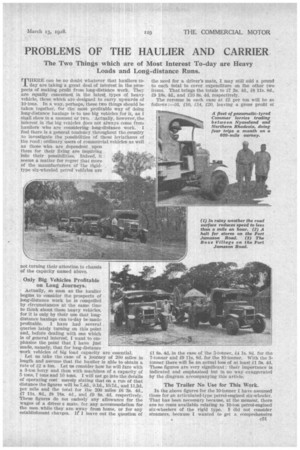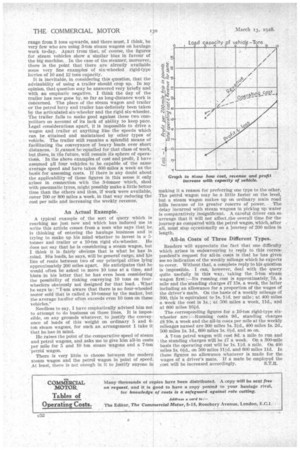PROBLEMS OF THE HAULIER AND CARRIER,
Page 81

Page 82

If you've noticed an error in this article please click here to report it so we can fix it.
The Two Things which are of Most Interest To-day are Heavy Loads and Long-distance Runs.
TIIERE can be no doubt whatever that hauliers today are taking a great deal of interest in the prospects of making profit from long-distance work. They are equally concerned in the latest types of heavy vehicle, those which are designed to carry upwards of 10 tons. In a way, perhaps,. these to things should be taken together, for the most profitable way of doing long-distance haulage is to use big vehicles for it, as I shall show in a moment or two. Actually, however, the interest in the big vehicles does not always come from hauliers who are conSidering long-distance work. I find there is a general tendency throughout the country to investigate the possibilities of these leviathans of the road : ordinary users of commercial vehicles as well as those who. are dependent :upon them for their living are inquiring into their possibilities. Indeed, it seems a matter for regret that more of the manufacturers of the rigidtype six-wheeled petrol vehicles are
not turning their attention to chassis of the capacity named above.
. Only Big Vehicles Profitable on Long Journeys.
Actually, so soon as the haulier begins to consider the prospects of long-distance work be is compelled by circumstances at the same time to think about these heavy vehicles, for it is only by their use that longdistance haulage can to-day be made profitable. I have had several . queries lately turning on this point and, before dealing with one which is of general interest, I want to emphasize the point that I have just made, namely, that for long-distance work vehicles of big load capacity are essential.
Let us take the case of a journey of 200 miles in length and assume that the haulier is able to obtain a rate of £2 a ton. Let us consider how he will fare with a 3-ton lorry and then with machines of a capacity of 5 tons, 7 tons and 10 tons. I will not go into the details of operating cost merely stating that on a run of that distance the figures will be 7,4d., 9.1d., mud.' and 11.3d. per mile and the total for the 200 miles id '3s. 4d., £7 11s. 8d., 18 18s. 4d, and £9 8s. 4d. respectively. These figures do not embody any allowance for the wages of a driver s mate, for any accommodation for the men. while they are away from home, or for any establishment charges. Its I leave out the question of
the need for a driver's mate, I may still add a pound to each total to cover expenditure on the other two items. That brings the totals to £7 3s. 4d., £8 11s. 8d., 19 18s. 4d., and £10 8s. 4d. respectively.
The revenue in each case at 12 per ton will be as follows :—£6, £10, 114, 120, leaving a gross profit of £1 8s. 4d. in the case of the 5-toriner, £4 is. 8d. for the 7-tonner and 19 us. 8d. for the 10-tonner. With the 3tonner. there will 5e an actual loss of at least £1 35. 4d. These figures are very significant: their importance is indicated and emphasized but in no way exaggerated by the diagram accompanying this article.
The Trailer No Use for This Work.
In the above figures for the 10-tonner I have assumed those for an articulated-type petrol-engined six-wheeler. That has been necessary because, at the moment, there are no costs available relating to 10-ton petrol-engined six-wheelers of, the rigid type. I did not consider steamers, because I wanted to get a. comprehensive
range from 3 tons upwards, and there must, I think, be very few who are using 3-ton steam wagons on haulage work to-day. Apart from that, of course, the figures for steam vehicles show a similar bias in favour of the big machine. In the case of the steamer, moreover, there is the point that there are already available some very fine examples of six-wheeled rigid-type lorries of 10 and 12 tons capacity.
It is inevitable, in considering this question, that the advisability of using a trailer should crop up. In my opinion, that question may be answered very briefly and with an emphatic negative. I think the day of the trailer has now gone by, so far as long-distance work is concerned. The place of the steam wagon and trailer or the petrol lorry and trailer has definitely been taken by the articulated-six-wheeler and the rigid six-wheeler. The trailer fails to make good against these two competitors on account of its lack of ability to keep pace. Legal considerations apart, it is impossible to drive a wagon and trailer at anything like the speeds which can be attained and maintained by other types of vehicle. The trailer still remains a splendid means of facilitating the conveyance a heavy loads over short distances. It icannot be equalled for that class of work, but there, in the future, will remain its sphere of operations. In the above examples of cost and profit, I have assumed all four vehicles to be capable of the same average speed and have taken 600 miles a week as the basis for assessing costs. If there is any doubt about the applicability of these figures in this sense it only arises in connection with the 3-tanner which, shod with pneumatic tyres, might possibly make a little better time than the others and thus, if work were available, cover 700 or 800 miles a week, in that way reducing the cost per mile and increasing the weekly revenue.
An Actual Example.
A typical example of the sort of query which is reaching me just now and which has induced me to write "this article comes from a man who says that he is thinking of entering the haulage business and is trying to make up his mind whether to invest in a 5fowler and trailer or a 10-ton rigid six-wheeler. Ile does not say that he is considering a 'steam wagon, but I think it is fairly obvious that is what he has in mind. His loads, he says, Will be general cargo, and his line of route between two of our principal cities lying approximately 200 miles apart. He anticipates that he would often be asked to move 10 tons at a time, and hints in his letter that he has even been considering the possibility of risking conveying 10 tons on fourwheelers obviously not designed for that load. What he says is: "I am aware that there is no four-wheeled motor sold that is called a 10-tonnes by the maker, but the average latelier often exceeds even 10 tons on these vehicles."
Needless to say, I have emphatically advised him not to attempt to do business on those lines. It is impossible, on any grounds whatever, to justify the conveyance of loads of this weight on ordinary 5 and 6ton steam wagons, for such an arrangement I take it that he has in mind.
He raises the point of the comparative speed of steam and petrol wagons, and asks me to give him all-in costs per mile for 5 and 10 ton steam wagons and a 7-ton `petrol wagon.
There is very little to choose between the moder steam wagon and the petrol wagon in point of ,speed. At least, there is not enough in it to justify anyone making it a reason: for preferring one type to the other. The petrol. wagon may be a little faster on the level, but a steam wagon makes up on ordinary main road hills because of its greater reserve of power. The delay inctrred with steam wagons in picking up water is comparatively insignificant. A careful driver can so arrange that it will not affect ,the overall time for the journey as compared with the petrol wagon, which, after all, must stop occasionally on a journey of 200 miles in length.
All-in Costs of Three Different Types.
Readers will appreciate the fact that one difficulty which arises in endeavouring to reply to this correspondent's request for all-in costs is that he has given roe no indication of the weekly mileage which he expects to cover. Without that, a complete reply to his question is impossible. I can, however, deal with the query quite usefully in this way, taking the 5-ton steain wagon first :—Its running cost is approximately. 7d. a mile and the'standing charges £7 15s. a week, the latter including an allowance for a proportion of the wages of the driver's mate. On the basis of a weekly mileage Of 300, this is equivalent to Is. lid. per mile ; at 400 miles a week the cost is Is.; at 500 miles a week, lid., and at 600 miles bid.
The corresponding figures for a 10-ton rigid-type sixwheeler are :—Running costs 9d., standing charges £8 10s. a week and the all-in costs per mile at the weekly mileages named are 300 miles is. 31d., 400 miles Is, 2d., 500 miles is. id., 600 miles is. Old. and so on.
A 7-ton petrol wagon will cost 8d. a mile to run and the standing charges will be £7 a week. On a 300-mile basis the operating cost will be is. lid. a mile. On 400 miles Is. Old., On 500 miles 11W. and 600 miles 11d. In these figures no allowance whatever is made for the wages of a driver's mate. If a mate be employed the
cost will be increased accordingly. S.T.R.




























































































































